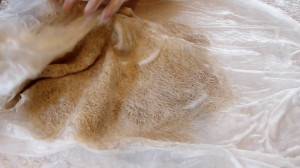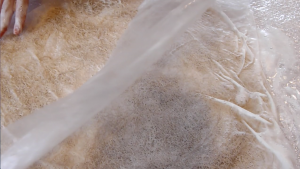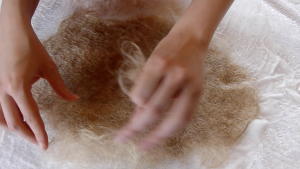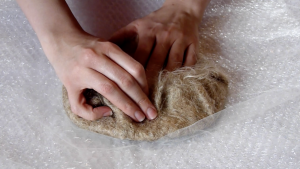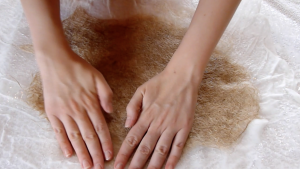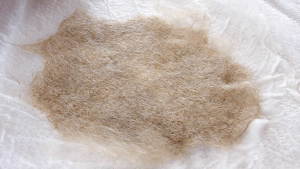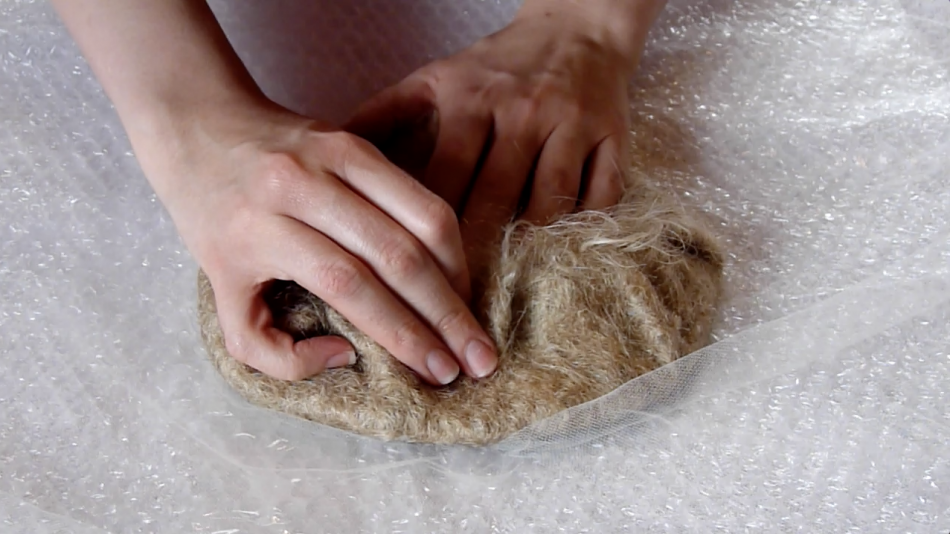
Untitled Film Still: folding the vessel
Mother-Skin: Liminality in Maternal Space
mother-skin multimedia installation
Exhibited at Peters Projects Santa Fe, NM 2015
Undergraduate BFA Thesis, SFUAD
Woman’s, daughter’s and granddaughter’s hair twines and is bound tightly, crossing mitochondrial DNA and matrilineal memory in the making of mother-skin, showing in form what is present in mind: the undeniable intermingling of identity and history between mother and daughter. For two years I collected my hair, pulling it from brushes, shower walls, fingers and knit clothes, accumulating it in a pile on my desk. In early spring of this year, my mother arrived at my door and placed in my hand a box of her own and her mother’s hair, collected in the same time-frame, for the same purpose and in the same way. The hair is combined in the hand-felted vessel of mother-skin.
The praxis of this work examines the construction of female identity in relationship to the mother through the rituals of brushing, saving, covering, and bathing. By engaging with inherited ceremonies of the mother-daughter-grandmother triad, mother-skin is a matrilineal social practice that considers how these maternal systems form identity and can be deconstructed as a means of individuation.
Ritual
The human being is made by rituals
the self must be collected
and collected
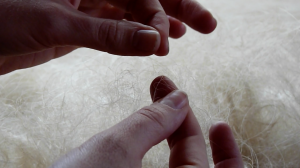
Untitled Film Still: gather the hair
In the technique of felting, materials must be covered with a veil or fine netting that allows soap and water to enter while keeping the fibers contained. To cover the hair with a veil is to reference covering the child with a blanket in the daily practice of putting to bed, as well as other diurnal rituals like bathing and swaddling, rituals of habit, relationship and language. The veil is the lamina, the amniotic covering that holds, protects, and eventually ruptures, giving way to the initial separation. Simultaneously, by performing this act of covering, the hair, and all the meaning it embodies, is laid to rest and symbolically resolved.
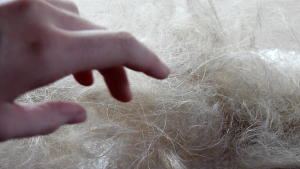
Untitled Film Still: gather the hair
20th-century anthropologist Arnold van Gennep unpacked the psychosocial implications of ritual, identifying that all sacred rites adhere to a three-level structure: preliminal (separation), liminal (transformation) and postliminal (reincorporation). Liminal space lacks a reference point. It is where all that is bound unbinds, the field of maternal potentia. Through this lens, the purpose of ritual ceremony is to enable the individual or community to pass “from one culturally defined state or status to another.” When the initiate crosses the limen, or the threshold, into liminal space, they symbolically leave the material world and enter into potential space and time.
Partaking in maternal rituals composes a circadian rhythm, the following of which constructs liminal, “out-of-time” time–the mother-child space being itself a liminal, transitional realm. Allowing the final felted object to hold meaning in place of the body enables both the mother and the daughter to cross back over the limen, out of the soupy, familial contents of the unconscious, and into the material world as discrete identities. In this way, the vessel is agentive: of the body but independent from the body, forever holding space and performing the syntax of the mother-daughter condition of being separate but together: the hair holds so that we may let go.
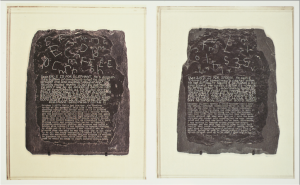
Post-Partum Document VI: Prewriting, Alphabet, Exergue and Diary Mary Kelly 1973- 1979
Mary Kelly examines maternal-child routines and the code of separation in Post-Partum Document (1973-1979), “a six year examination of the mother-child relationship.” In Post-Partum, Kelly methodically catalogs objects and occurrences from the mother-child space such as fecal stains in diapers and audio recordings of her son’s progression from “holophrastic utterances” to formed speech. Here, loss is counted and recounted, codified through documentation–another form of collecting. The precise recording of facts bridges the gap between inside and outside, the unconscious and the conscious. It is a rope, the Ariadne’s thread the mother grips and follows. Through marking time by measuring infant progress, the mother steadies herself out of the mother-child dyad and back into individual identity.
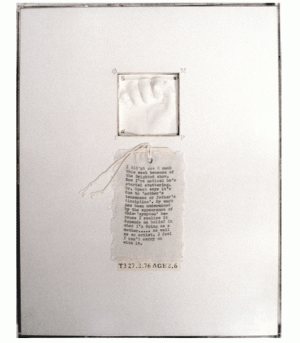
Post-Partum Document IV: Transitional Objects, Diary and Diagram Mary Kelly 1973- 1979
Post-ritual and the Risk of the Liminal Loop
In mother-skin, the most crucial moment of the process is the act of bringing a practice that occurs in the intimate spaces where I collect my hair (my bath, my bed, my body) into the public sphere. This is the postliminal stage of the rite that prevents the subject from getting trapped in the never-ending loop of self-reflexivity. In this context, objectification is a form of liberation.
Stories are recounted of my Grandmother’s elaborate routines of washing my mother’s hair. First soap, then a vinegar bath, followed by laborious fine-toothed combing into the night. Finally, the hair is rolled in baby socks to be slept in and unrolled in the morning, the hair itself passing through the stages of ritual transformation. These actions generate a text, the semantics of which reference the liturgy of female body practices: standing still, self-cleansing, combing/sorting as in laundry or even carding fibers for making thread, waiting, and, at last, transformation through sleep.
Faith Wilding performs woman-space as (eternal) liminal space in Waiting (1972), a scripted piece wherein Wilding “condenses a woman’s entire life into a monotonous, repetitive cycle of waiting for life to begin.” In Waiting, Woman is located in limbo between cause and effect, forever almost-there, stuck in the “disorienting ambiguity” of in between-space. The subject has crossed the limen into suspended time, but is never able to cross back into the material world. In the case of Waiting, it is culturally imposed gender norms and institutionalized sexism that keeps Woman in the unending space-time of the private sphere. This shows the importance of constructed ceremonies that allow women access to lateral movement, and not just the vertical ascension and descension of never ending cycles of housework, domestic management, and visage perfection. This cycle is not the “periodicity of self” that is referenced in the mother-skin narrative, but is more like a frozen clock, imprisoning the female body in suspended animation, like Sleeping Beauty or Snow White.
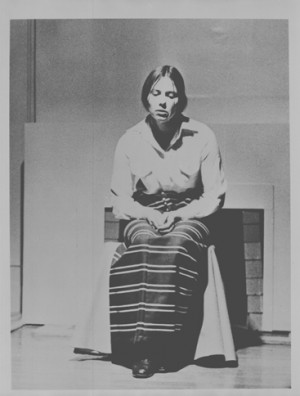
Photograph of Faith Wilding performing Waiting at the feminist art installation and performance space, Womanhouse 1972
Without the postliminal phase of the self-constructed ritual, identity remains indeterminate and still, unstructured and translucent, like the webbed piles of collected hair. Without transition, the woman’s psyche does not develop, cannot take shape, cannot enact itself on the world but remains passive. Left in the polluted state of liminal stagnation, the maternal-child relationship becomes the destructive Jungian complex, it too being passed down generationally in the form of ritual. By recounting the matrilineal history and mythology, returning to and appropriating the practices, gestures, and linguistics of this inheritance, the complex can be transformed into a powerful personal legacy that holds meaning and time. The transformation is evidenced in the sheer tensile strength of the felted hair vessel. Now, with the self as the woof and the motherline as the warp, the ancient woman-centered practice of fiber-making renders the fabric of the female psyche pliable but able to withstand time and erosion. The methodology of (re)collection of female identity offers a tangible examination of physical and psychic loss in the semiotics of the mother-daughter relationship.

